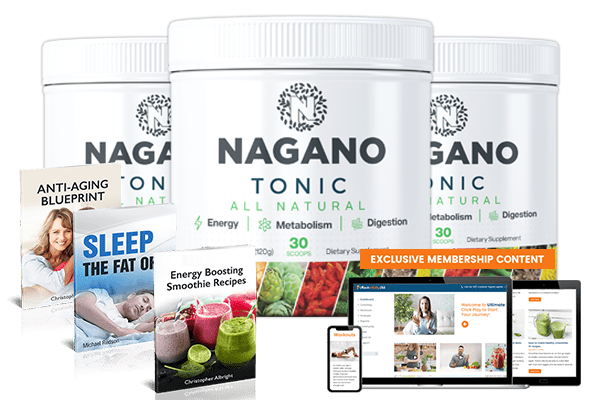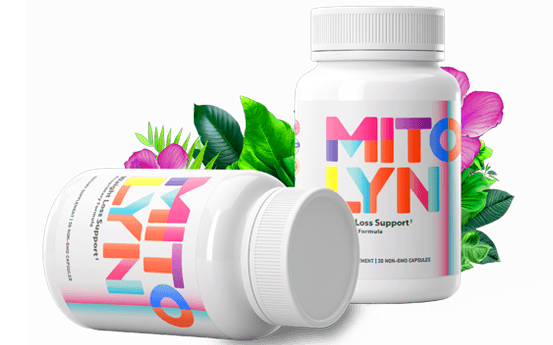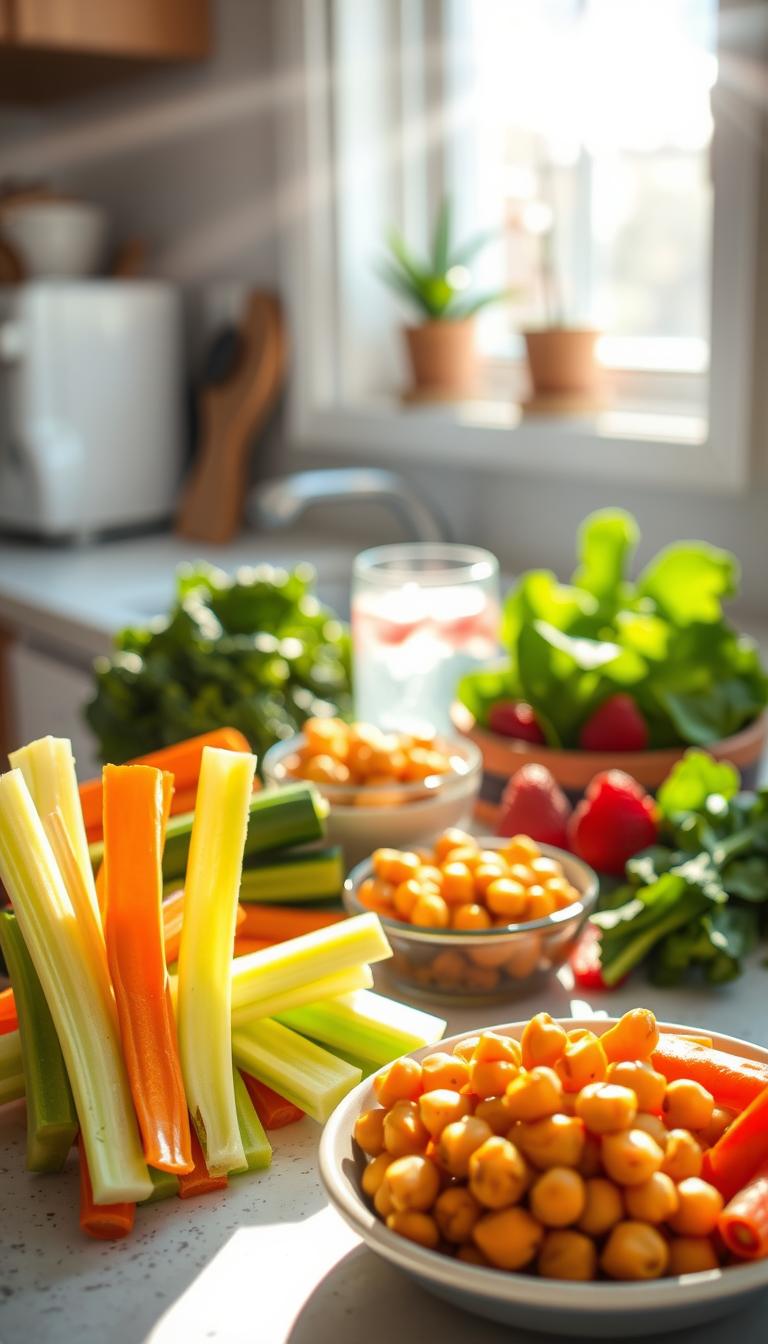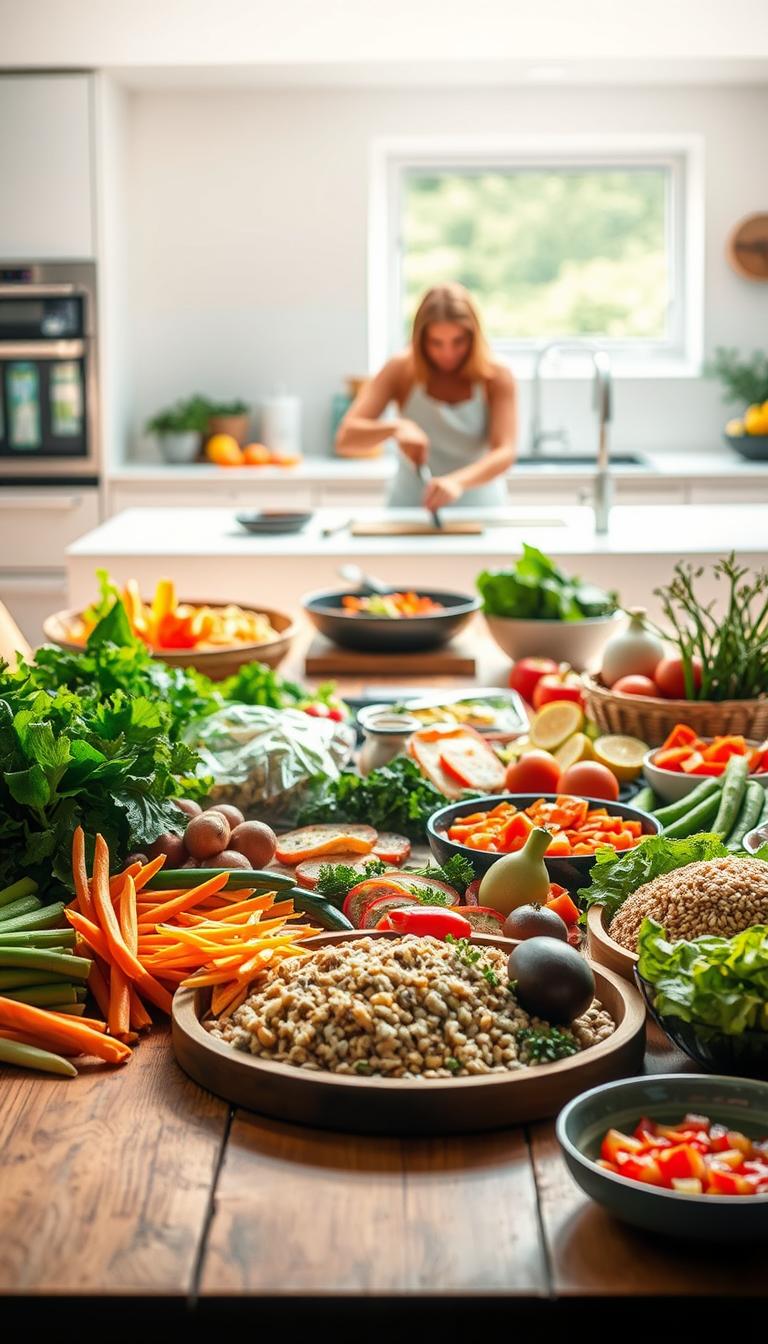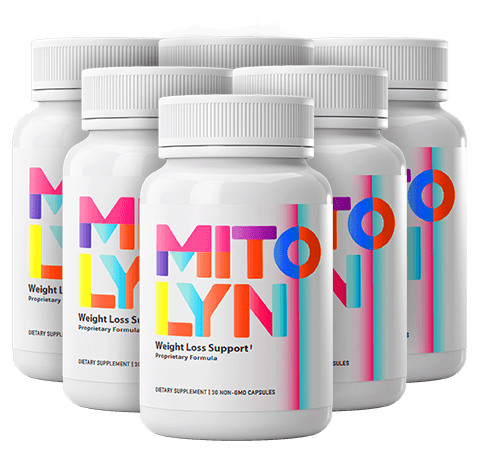
Do you remember the first time you had a crisp salad after a long week? That feeling when a simple spinach salad or a vibrant green smoothie made you feel alive? Green foods are more than a trend. They give you energy, strength, and a brighter outlook on life.
Imagine eating foods full of vitamins K, A, and C. Plus, they help reduce your carbon footprint. That’s the power of green foods.
Green foods are your secret allies. They can be a steamy kale dish or a quick snack of avocado. These foods make every meal a nutrient bomb. They fight for your heart, brain, and even the planet. Ready to join the green revolution?
Key Takeaways
- Green foods like kale and spinach deliver vitamins K, A, and C in every bite.
- Switching to plant-based meals can cut carbon emissions by up to 40%, helping both your health and the planet.
- Leafy greens like collard greens and bok choy boost energy and may lower disease risks like heart issues.
- Easy to add to any meal—think watercress in salads or avocado in wraps.
- Small changes, like swapping red meat for green veggies, add years of healthy living.
What Are Green Foods and Why Should You Care?
Green foods are more than a trend. They are packed with nutrients from plants. Leafy greens, cruciferous veggies, and superfoods like kale and spinach are great choices. They support your body and taste good.
Defining Green Foods in Modern Nutrition
Today, green foods mean veggies and plants full of chlorophyll, vitamins, and minerals. Think spinach, broccoli, and bok choy. They are low in calories but high in fiber and antioxidants.
For example, one cup of raw spinach has 181% of your daily Vitamin K and 56% of Vitamin A. Kale and collards are even more packed with nutrients.
- Spinach: 10 calories per half-cup serving
- Kale: 3 grams of protein per serving
- Collards: 49 calories per cooked cup
The Historical Significance of Green Foods
“Civilizations from ancient Egypt to medieval Europe used green vegetables as both medicine and food.”
For centuries, people around the world used green plants for health. Now, science backs their benefits. Eating green veggies daily can lower heart disease risk by 15.8%.
Antioxidants in greens fight inflammation and free radicals.
Green Foods vs. Other Food Groups
Greens have special benefits compared to other foods. While fruits give vitamins, greens like broccoli and asparagus offer fiber and minerals. They have fewer calories but more nutrients.
One cup of cooked collard greens has 308% of your daily Vitamin A. No other food group can match this.
Choosing greens adds color and nutrients to your meals. They fight chronic diseases and support your health. Every bite makes you stronger and healthier.
The Remarkable Health Benefits of Green Foods
Healthy green foods are more than just colorful. They are nutritional powerhouses. Leafy greens like spinach and kale are full of vitamins A, C, K, and potassium. These support your immunity, bone health, and heart function.
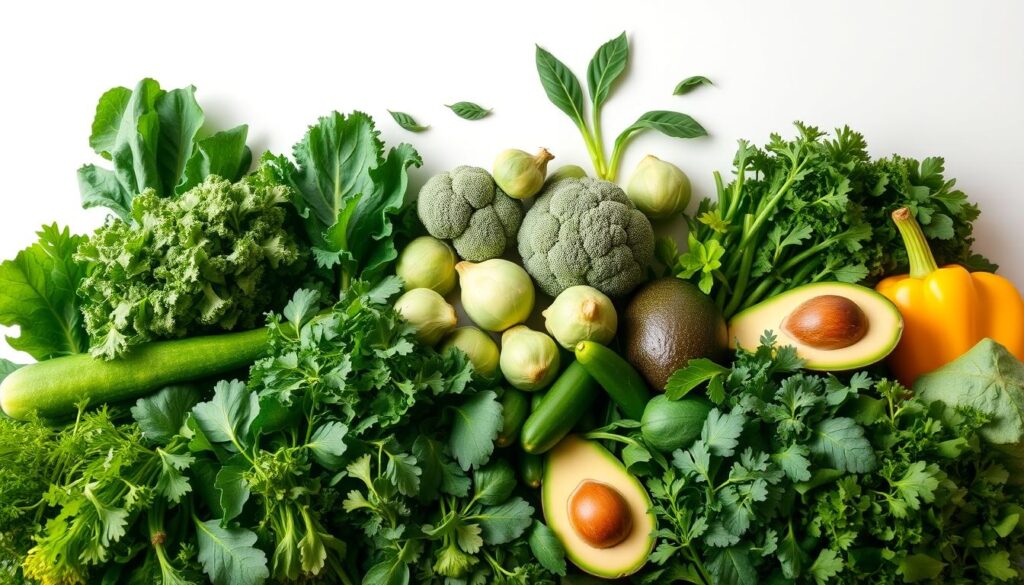
One cup of cooked spinach has 840 mg of potassium. This helps you meet daily needs without extra calories. These greens also have chlorophyll, which helps your body get rid of toxins and boosts energy.
Their fiber content aids digestion and keeps you full longer. This makes them great for maintaining a healthy weight.
- Reduce inflammation linked to chronic diseases
- Support brain health—daily leafy greens may slow cognitive decline
- Lower blood pressure and improve heart health
- Enhance bone strength through vitamin K and calcium
Think of green food benefits as your body’s natural defense system. Adding herbs like basil or parsley to meals boosts vitamins. Swapping lettuce for nutrient-dense kale in salads amplifies gains.
Even small changes, like mixing spinach into eggs or smoothies, can make a big difference. Your body deserves the antioxidant power of these greens. They fight oxidative stress and support overall wellness.
Science shows chlorophyll in greens binds to toxins, aiding detox. Fiber fuels gut-friendly bacteria. Prioritizing healthy green foods is not just a trend. It’s a step toward lasting vitality. Every bite of these vibrant plants works to protect your heart, bones, brain, and energy levels.
Top 10 Nutrient-Rich Green Foods to Add to Your Diet
Want to make your meals healthier? Try adding the best green foods. Foods like spinach and broccoli are full of vitamins, fiber, and antioxidants. They can turn your meals into a health boost.
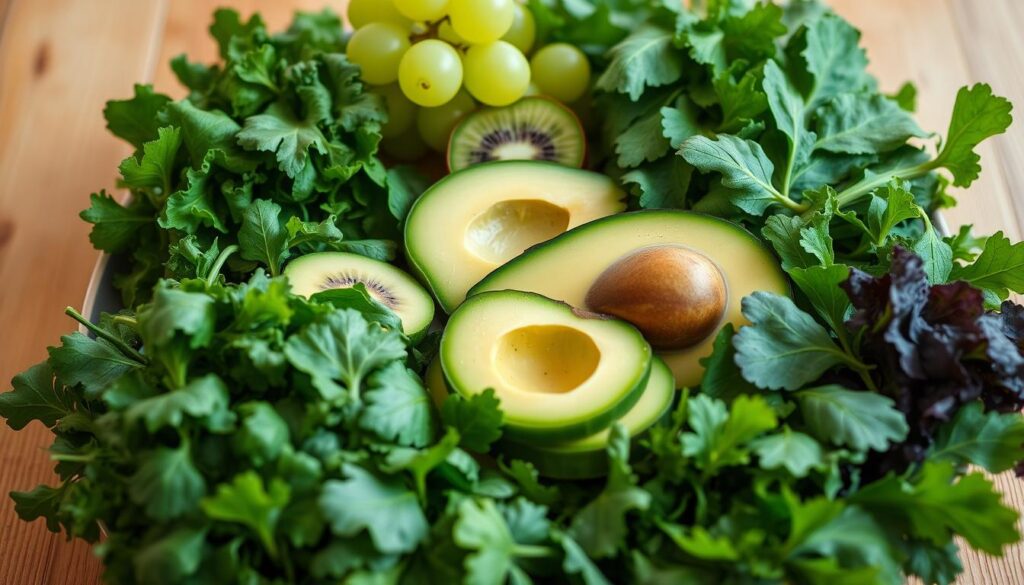
Leafy Greens: Kale, Spinach, and Collards
Leafy greens are like nature’s vitamins. Here are some great ones:
- Spinach: 1 cup has 121 mcg vitamin K (over 100% daily needs) plus iron and folate. Add it to salads or sauté lightly.
- Kale: With 684% DV vitamin K per cup, it’s perfect for smoothies or salads.
- Collards: They’re full of calcium and vitamin K for strong bones. Steam or add to soups for a boost.
Green Vegetables: Broccoli, Brussels Sprouts, and Asparagus
These veggies are full of nutrients:
- Broccoli: Rich in vitamins C and K. A 1-cup serving has 3.3g fiber and antioxidants.
- Brussels Sprouts: 3g protein per cup and vitamin K. Roast with olive oil for a crispy texture.
- Asparagus: It has B vitamins and 2g protein per cup. Grill or steam as a quick side dish.
Green Fruits: Avocados, Green Apples, and Kiwis
Don’t forget these sweet and savory fruits:
- Avocados: They’re full of healthy fats and fiber. Mash onto toast or blend into smoothies.
- Green Apples: They’re high in fiber and vitamin C. Snack on or add to salads.
- Kiwis: They have double the vitamin C of oranges. Slice into yogurt or salads.
Green Superfoods: Spirulina, Chlorella, and Wheatgrass
These green superfoods are packed with nutrients:
- Spirulina: A blue-green algae with iron and B vitamins. Mix into juices or smoothies.
- Chlorella: It’s high in protein and chlorophyll. Take as a supplement or powder.
- Wheatgrass: It’s detoxifying and rich in enzymes. Sip as a shot or add to shakes.
How Green Foods Support Weight Management and Detoxification
Green foods are great for staying healthy. They have fiber, are low in calories, and have natural compounds. These help you feel full, stay energized, and detox naturally.
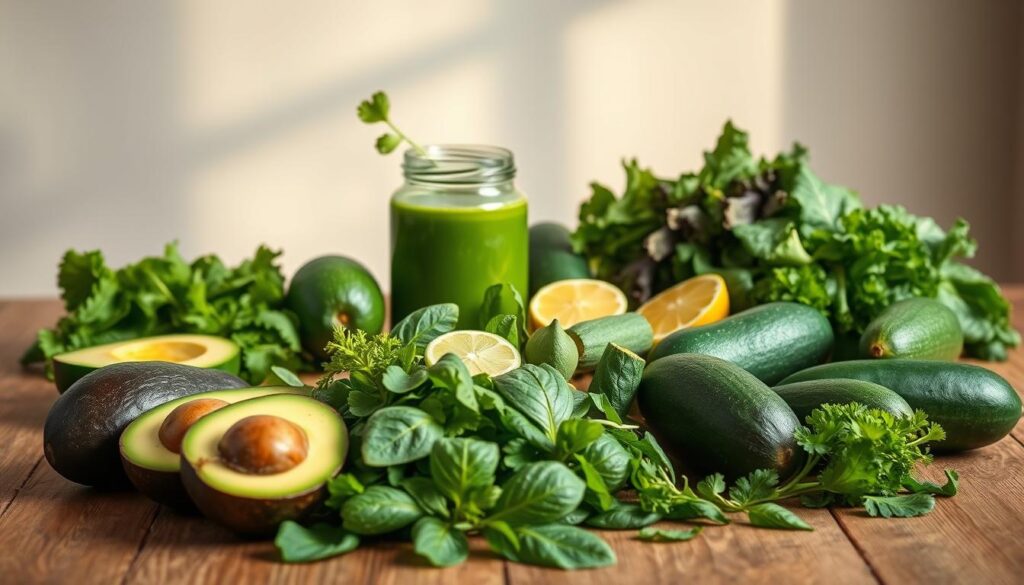
Fiber Content and Satiety Factor
Leafy greens like kale and spinach are full of fiber. The Institute of Medicine says we need 25–38 grams a day. Healthy green foods help meet this need.
A cup of cooked collard greens has 8 grams of fiber. This makes you feel full longer, cutting down on cravings. But, juicing can lose fiber. So, eat whole greens for the best benefits.
Low-Calorie, Nutrient-Dense Options
Vegetables like broccoli and asparagus are green foods with lots of taste and few calories. A cup of raw spinach has just 7 calories. It also has vitamins A and K.
Try these tips to eat more greens:
- Add spinach to omelets or smoothies
- Swap lettuce wraps for taco night
- Snack on cucumber slices with hummus
Natural Detoxifying Properties
Your liver detoxes on its own, but green foods help it more. Cilantro has compounds that reduce heavy metals. Antioxidants in kale fight off harmful free radicals.
But, don’t overdo it. Too much green juice, especially with oxalates like in spinach, can hurt your kidneys. This is especially true if you have health problems.
“Dietary fiber increases detox enzymes in the liver, enhancing its natural processes.” – 2016 Review
Add these green foods to your meals wisely. This way, you’ll see lasting benefits.
The Science Behind Green Food Benefits
Learning about green foods shows why they’re good for health. A study followed 960 seniors. Those eating 1.3 servings of leafy greens a day seemed 11 years younger. This isn’t magic—it’s because of nutrients like antioxidants, vitamins, and fiber.
Higher green leafy intake correlated with cognitive aging delayed by over a decade, says the Memory and Aging Project.
Green foods have special compounds that protect us:
- Lutein and zeaxanthin shield our eyes from damage as we age.
- Phylloquinone (vitamin K1) lowers diabetes risk by 51% in high-risk groups.
- Inulin, a fiber, helps good bacteria in our gut for digestion and immunity.
- B vitamins like folate and B12 boost energy and help red blood cells.
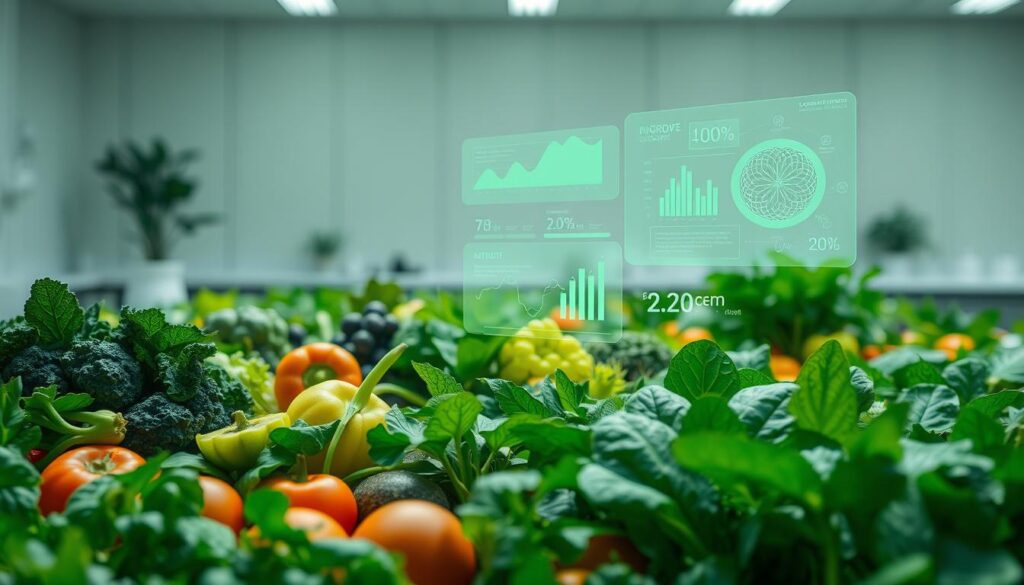
These nutrients fight inflammation and oxidative stress. The DASH diet, full of greens, lowers blood pressure. Mediterranean diets, rich in greens, reduce heart disease risk by 30% with daily consumption. Even a little extra fruit or veggie lowers heart disease death risk by 4%.
Nutrients like kaempferol and alpha-tocopherol (vitamin E) fight off harmful free radicals. Eating green foods every day gives your body tools to fight aging and disease. Their antioxidants and fiber make them a natural shield for long-term health.
Organic Green Foods: Are They Worth the Extra Cost?
Choosing between organic and conventional 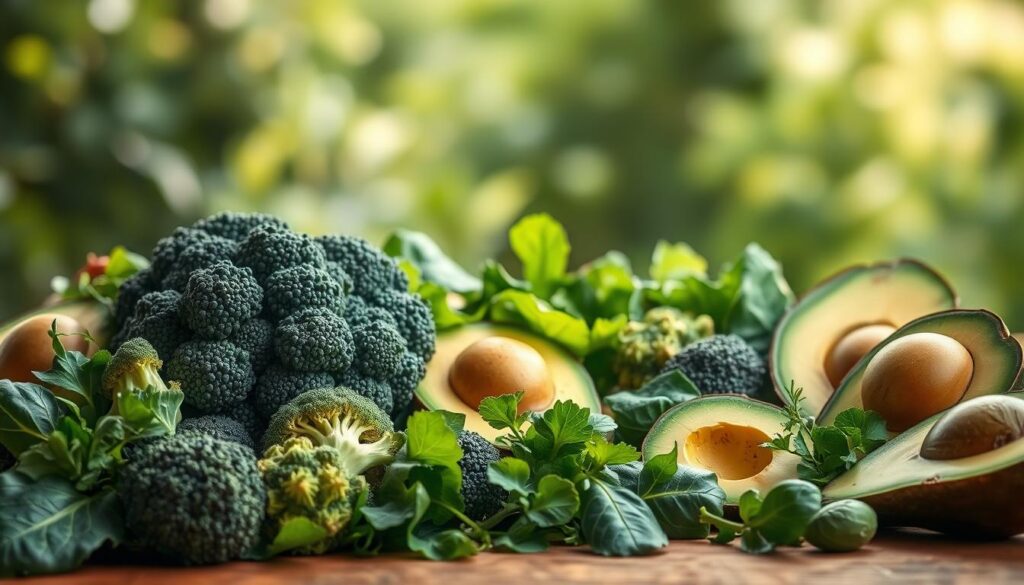
Pesticide Exposure in Conventional vs. Organic Green Foods
Organic green foods have about 30% less pesticide residue than non-organic ones. Leafy greens like spinach often have high pesticide levels. But, both must meet safety standards.
The USDA Organic seal means products are at least 95% organic.
Nutritional Differences Between Organic and Conventional Options
Studies show small nutritional differences. Organic milk and meat have a bit more omega-3s. But, veggies show little difference.
Both types of green foods are full of important nutrients. So, don’t skip them even if organic isn’t available.
When to Prioritize Organic Purchases
Make these smart swaps:
- Opt for organic spinach, berries, and leafy greens (EWG’s “Dirty Dozen”)
- Buy conventional options for thick-skinned produce like avocados or pineapples (“Clean Fifteen”)
- Choose frozen organic options for budget-friendly savings
“Pick what matters most to you—whether it’s reducing pesticides, supporting eco-farms, or simply enjoying more green foods,” says a 2023 USDA dietary guide.
Save money by shopping in-season, joining a CSA, or mixing organic and conventional choices. Every bite of organic green foods counts. But, health wins even with non-organic varieties. Make choices that fit your values and budget!
Easy Ways to Incorporate More Green Foods Into Your Daily Meals
Boost your intake of green foods without changing your routine too much. Start small by adding spinach to omelets or blending kale into overnight oats. You can also sneak veggies into foods like pizza crusts or pasta sauces for extra nutrition.
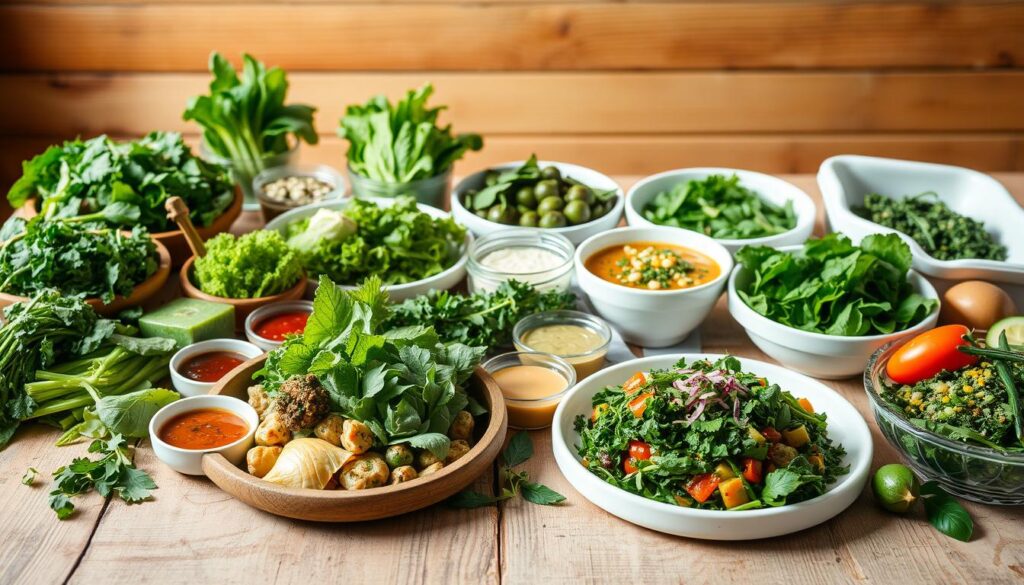
- Morning boost: Blend spinach, banana, and almond milk into a creamy green smoothie.
- Lunch hacks: Top sandwiches with shredded cabbage or cucumber slices.
- Snack smart: Pair cherry tomatoes with guacamole or drizzle balsamic glaze on roasted green beans.
Try these green food recipes that are under 200 calories per serving:
| Recipe | Calories | Key Nutrients |
|---|---|---|
| Spinach-Orzo Salad | 122 | Protein 5g | Fiber 4g |
| Greens & Beans Turkey Soup | 105 | Iron 15% DV | Vitamin A 20% DV |
| Kale Quinoa Salad | 190 | Fiber 3g | Protein 6g |
Swap iceberg lettuce for collard greens in wraps. Puree broccoli into mac & cheese sauce for a creamy texture. The CDC says only 1 in 10 Americans eat enough veggies. Make it fun with these tricks!
Delicious Green Food Recipes Even Picky Eaters Will Love
Make greens into meals your family will love with these green food recipes. They use the best green foods in exciting ways. Say goodbye to bitter leaves and bland salads. Instead, enjoy bold flavors and creative twists.
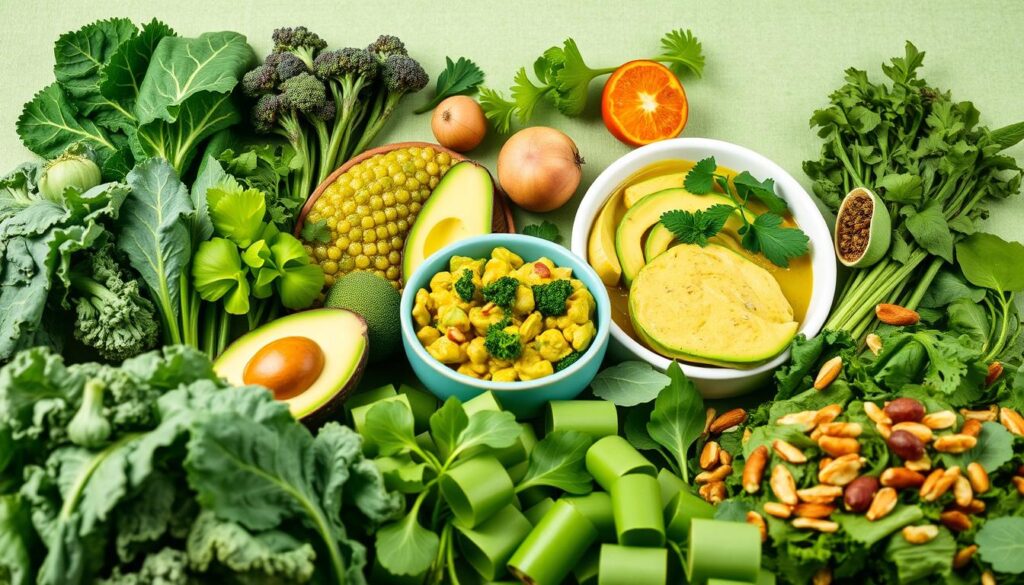
“Roasting brings out natural sweetness—no gagging anymore,” says nutritionist Palumbo. She shares her secret for making asparagus a hit with lemon and sesame.
| Recipe | Calories | Key Greens |
|---|---|---|
| Creamed Peas | 110 | Peas, butter, cream |
| Garlic Green Beans | 125 | Green beans, garlic |
| Avocado Dip | 90 | Avocado, basil |
Pair best green foods like broccoli or asparagus with familiar flavors. Think cheese, citrus, or nutty sesame. Prep ahead with roasted veggies for easy snacks. Even the pickiest eaters will want more when greens are presented in new ways!
Shopping and Storage Tips for Fresh Green Foods
Keeping nutrient-rich green foods fresh starts with smart shopping and storage. Follow these tips to keep your greens crisp and full of nutrition for longer.
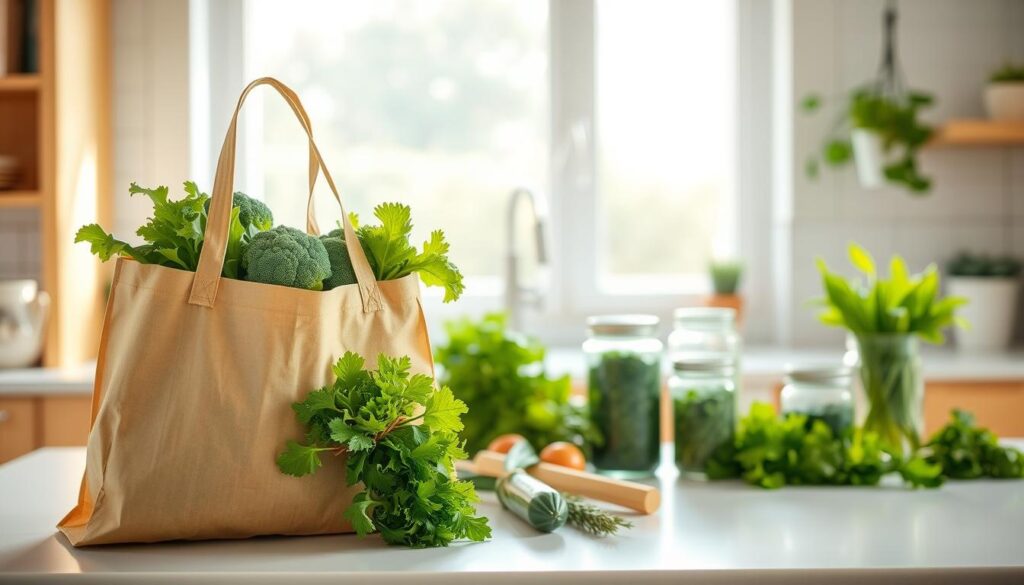
Seasonal Guide to Green Foods
Shop seasonally for the best flavor and price. Here’s what to pick each season:
- Spring: Asparagus, spinach, and tender lettuces
- Summer: Tomatoes, cucumumbers, and green beans
- Fall: Kale, Brussels sprouts, and winter squash
- Winter: Citrus, root vegetables, and hardy greens
How to Select the Freshest Green Foods
Choose greens with vibrant color and firm texture. Avoid limp leaves, spots, or wilted stems. Pre-washed greens are safe to use without re-washing—saving time and keeping them fresh.
Proper Storage Methods
Use these techniques to keep greens fresh longer:
| Green Food | Storage Method | Tip |
|---|---|---|
| Lettuces | Refrigerator | Wrap in paper towels to absorb moisture |
| Tomatoes | Room temperature | Refrigeration ruins flavor and texture |
| Apples | Refrigerator | Keep in crisper drawer for longer freshness |
| Root vegetables | Pantry | Store in ventilated bins away from light |
Keep ethylene-producing fruits (apples, bananas) away from ethylene-sensitive veggies (leafy greens) to prevent spoilage. Use airtight containers for cut produce and wash greens only before use.
With these strategies, you’ll reduce waste and keep green foods tasting their best. Every bite of freshness counts toward your health goals!
Common Myths About Green Foods Debunked
Let’s clear up some confusion about green foods. Many people avoid them because of myths that don’t hold up to science. Here’s what you should know:
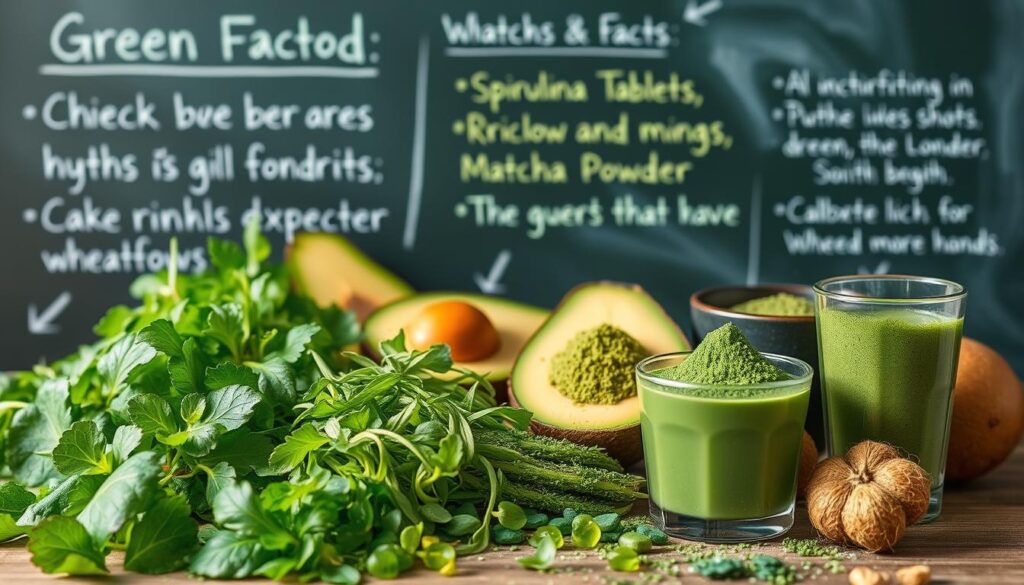
- Myth 1: “Green foods taste bitter and unappetizing.” Roasting, steaming, or adding a drizzle of olive oil can balance flavors. Kale, for example, caramelizes when roasted, bringing out natural sweetness.
- Myth 2: “You must eat them raw to get nutrients.” Cooking enhances some nutrients. For instance, lightly steaming spinach boosts vitamin A absorption. Overcooking is the problem, not cooking itself.
- Myth 3: “Powder supplements replace whole green superfoods.” Powders are convenient, but whole foods offer fiber and phytonutrients you miss in pills. Use supplements as extras, not replacements.
- Myth 4: “Organic green foods are always better.” A 2017 study found no major nutritional difference between organic and conventional produce. Focus on washing techniques—running water or blanching removes 90% of pesticides, per a 2022 Foods study.
- Myth 5: “They’re too expensive.” Frozen options cost less and retain nutrients. Canned beans or frozen peas are budget-friendly. Buying seasonal produce lowers costs further.
Myths can hold you back, but the facts show green foods are accessible and flexible. Start small—try a spinach salad or a broccoli snack. Your plate (and planet) will thank you!
Conclusion: Transform Your Health With the Power of Green Foods
Green foods are full of vitamins, fiber, and antioxidants. They boost your health in many ways. Kale has vitamin C, and spinach has iron.
These foods help your immunity, heart health, and energy. Even a small amount, like a cup of broccoli, can make a big difference. Starting with just one serving a day can lead to better wellness.
Experts like Dr. Caldwell Esselstyn say eat leafy greens six times a day for heart health. Studies show green foods’ antioxidants lower disease risk. Spinach’s magnesium and potassium help lower blood pressure.
Avocado’s healthy fats support brain function. The American Diabetes Association suggests 3-5 servings of non-starchy veggies daily. This helps manage blood sugar and weight.
Having trouble eating enough? Try greens powders like Athletic Greens or Amazing Grass, but talk to a doctor first. These supplements aren’t a full replacement for whole foods. They can help active people or those with dietary gaps.
Always choose fresh options like kiwi, asparagus, or Brussels sprouts for fiber and nutrients. Start small. Add greens to smoothies, top salads with avocado, or snack on sugar snap peas.
Every bite of green foods counts toward your daily goal. Remember, even a handful of spinach in your morning omelet builds lasting habits. Your future self will thank you for choosing nutrient-dense choices today.




